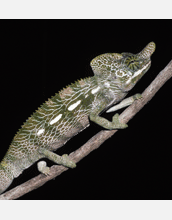Multimedia Gallery
Labord's Chameleon From Madagascar
Adult male Labord's chameleon (Furcifer labordi) from southwestern Madagascar. These species of tetrapod (four-limbed vertebrates) have the shortest lifespan ever recorded for a four-legged vertebrate animal--just 4-5 months post-hatch--and spend more of their short life inside the egg than outside. No other tetrapods are known to have this short a life span. These findings suggest that the rapid death of chameleons in captivity may, for some species, actually represent the natural adult life span.
Labord's chameleons hatch from eggs in November, then grow at an astonishing rate, reaching sexual maturity by January. They battle fiercely over mates, then breed and lay their eggs by February, after which they will promptly drop dead. For the next nine months, the entire species is represented only by eggs.
More about this Image
Christopher John Raxworthy received a CAREER (Faculty Early Career Advancement) award from the National Science Foundation to complete a survey of amphibians, reptiles and small mammals and their co-evolved parasites at 15 sites in the Tsaratanana Massif Complex of Madagascar; describe new species, revise taxonomic groups and produce species lists, monographs, keys and field guides; and establish a website-accessible database for use with future research work and conservation planning.
When he began his research, only about 400 species of Malagasy reptiles and amphibians had been identified, and the information available about these species was often inaccurate or incomplete. Through his research, Raxworthy has found (and is now describing) more than 150 new species and has added a wealth of information to the database on known species. Currently, he is focusing his research on chameleon systematics, a project that includes field surveys in remote, mountainous areas of northern Madagascar. Many of these areas have never been previously explored or surveyed. [Research supported by NSF grant DEB 99-84496.] (Date of Image: unknown)
Credit: Christopher Raxworthy
Images and other media in the National Science Foundation Multimedia Gallery are available for use in print and electronic material by NSF employees, members of the media, university staff, teachers and the general public. All media in the gallery are intended for personal, educational and nonprofit/non-commercial use only.
Images credited to the National Science Foundation, a federal agency, are in the public domain. The images were created by employees of the United States Government as part of their official duties or prepared by contractors as "works for hire" for NSF. You may freely use NSF-credited images and, at your discretion, credit NSF with a "Courtesy: National Science Foundation" notation.
Additional information about general usage can be found in Conditions.
Also Available:
Download the high-resolution JPG version of the image. (1.3 MB)
Use your mouse to right-click (Mac users may need to Ctrl-click) the link above and choose the option that will save the file or target to your computer.



